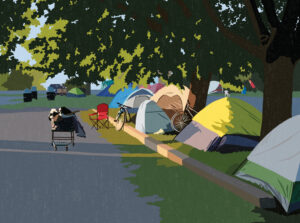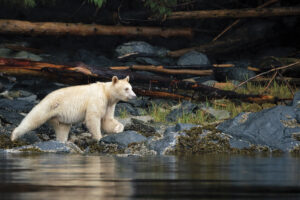
People & Culture
Kahkiihtwaam ee-pee-kiiweehtataahk: Bringing it back home again
The story of how a critically endangered Indigenous language can be saved
- 6310 words
- 26 minutes
People & Culture

Layla Cameron is a fat activist, artist, journalist, documentary filmmaker and PhD candidate at the School of Communication at B.C.’s Simon Fraser University, where her research focuses on social justice movements and media.
Canadian Geographic spoke with Cameron as part of our Colour the Trails series.
On how her work began
I would say that my fat activist work started when I was 14 and a finalist in a modeling contest for Seventeen Magazine. I was the only plus-size contestant, and I was adamant in my application that a publication that claimed to represent the average ‘all-American’ teen could not possibly achieve that goal without increasing the sizes of the models they used. This was in 2004-2005, before plus-size modeling became as popular as it is now. I ended up being flown to New York City and doing a shoot for the magazine and this emboldened me to speak out more about how I felt about my body and how it was treated.
On fat activism
I moved to British Columbia from Ontario largely with the intention to spend more time outside. When I settled in Vancouver, I noticed that there were very few people on the trails who looked like me and that there were no options in the city for buying sporting gear for larger bodies.
However, it wasn’t only the lack of accessibility to these items or the lack of visibility of diverse bodies that highlighted the importance of fat activism. The underlying fatphobic attitudes in the athletic communities here were also incredibly harmful. It made me feel like even if there had been a plus-size clothing goods store, the air of hostility and outright disgust fat people are often subjected to in fitness settings would — understandably so — turn many people off from participating. This hostility on the trails or other fitness environments has always seemed so hypocritical to me, considering that the people who perpetuate these harmful attitudes are often also the ones who believe that fat people should be more active.
Once I found Fat Girls Hiking [in Oregon] and filmed Fat Hiking Club, and once I started to build a fat community here in Vancouver — including co-founding a fats-only softball team called The Heavy Hitters — I really felt like not only was fat-positive ideology needed in sporting environments, but that change might actually be possible.
On working in documentary film
Documentary film has always been my ideal form of expression. I think that documentary has incredible potential to educate and influence viewers about positionalities that they may never have been, or would be, exposed to. Importantly, documentary often also requires that these stories be told by people who are actually experiencing the broader social issue at hand. As well, while there are other gatekeeping aspects to documentary that greatly influence the diversity of stories being told — for one, it’s very expensive and time-consuming — I do believe that, as a visual medium, documentary can be empowering for those who inhabit bodies that have been greatly left out of the public eye or are represented in mainstream media in harmful and often violent ways.
On the response to her work
The response to my work has always been mixed. On the one hand, there is usually a sense of comradery amongst fat consumers of my art or academic work. I have received many e-mails from fat folks who express that something I produced resonated with them, which is always extremely validating and heartwarming because at the end of the day, that’s who my work is for.
On the other hand, I have experienced intense anger, retaliation and trolling from folks who not only disagree with my views but also seem to be personally outraged by me and my work. This commentary often serves no purpose, but sometimes these responses stem from deeply ingrained societal biases and assumptions, particularly in regard to conceptions of health. I have essentially had to become a medical practitioner with the amount of public health literature I have armed myself with to dismantle these assumptions, in order for a resistant audience to be open to conversations about fat people participating in outdoor sporting culture. While I unfortunately often have to occupy the position that being fat does not equate to being unhealthy, what I really want to get across to folks who hold these attitudes is that someone’s health is no one else’s business, and that there really is no moral imperative to be healthy. Regardless of one’s health status, everyone still deserves respect, dignity and to have their accessibility needs met so that they can participate in whatever activity they would like to do.
On applying the lessons she promotes to all aspects of diversity in the outdoors
One of my guiding principles comes from an outdoor recreational camp for fat folks that I attended on Orcas Island in Washington state, called Wild Abundance Expeditions. The principle states to leave “No Fatty Left Behind”, meaning that it is our responsibility to meet the needs of every participant and actively work to make sure that anyone who wants to participate in an activity can do so comfortably.
When we are planning or executing an outdoor activity, we should be operating from the needs of the most marginalized participant. It is important that we do not treat that responsibility as a burden, but as a privilege.
On what’s next
I have just launched a fat-positive design company called Stay Fat Design Co.! The online shop sells a range of products and has worked fat activist ideology into its operations in some pretty neat ways, my personal favourite being the application of the ‘fat tax’ to smaller sized apparel. In the midst of this launch, I’m also wrapping up a complete draft of my PhD thesis. My partner and I are hoping to get back on the road and live the van life as soon as it is safe to do so, but in the meantime we’re happy to isolate at home and do our part to keep our communities safe. I have to admit, though, I’m really missing exploring our national parks!
Are you passionate about Canadian geography?
You can support Canadian Geographic in 3 ways:

People & Culture
The story of how a critically endangered Indigenous language can be saved

People & Culture
For unhoused residents and those who help them, the pandemic was another wave in a rising tide of challenges

Wildlife
How ‘maas ol, the spirit bear, connects us to the last glacial maximum of the Pacific Northwest

Places
In Banff National Park, Alberta, as in protected areas across the country, managers find it difficult to balance the desire of people to experience wilderness with an imperative to conserve it